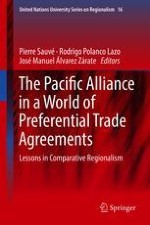
2019 | OriginalPaper | Buchkapitel
1. The Pacific Alliance: Building a Pathway to the High-Hanging Fruits of Deep Integration
verfasst von : Ana María Palacio Valencia
Erschienen in: The Pacific Alliance in a World of Preferential Trade Agreements
Aktivieren Sie unsere intelligente Suche, um passende Fachinhalte oder Patente zu finden.
Wählen Sie Textabschnitte aus um mit Künstlicher Intelligenz passenden Patente zu finden. powered by
Markieren Sie Textabschnitte, um KI-gestützt weitere passende Inhalte zu finden. powered by